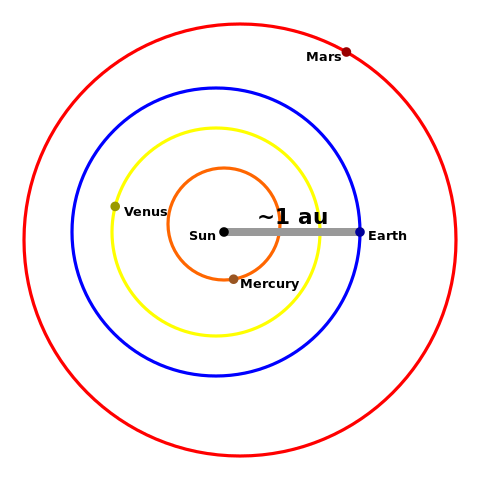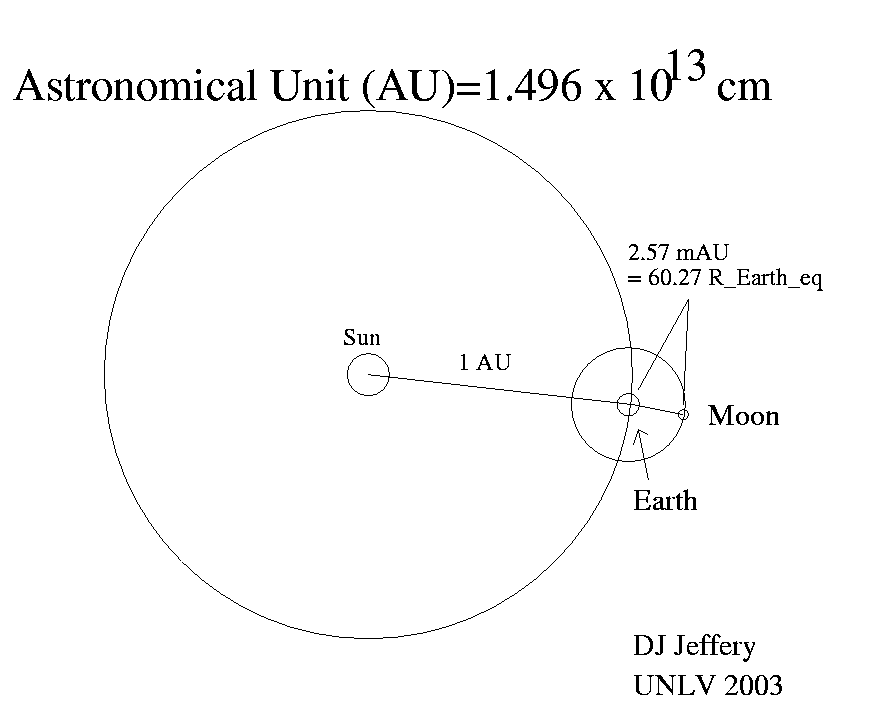
Image 1 Caption: An image introducing the astronomical unit (AU): the disance unit equal to the mean Earth-Sun distance is, of course, the mean orbital radius of the Earth's orbit. The astronomical unit is the good natural unit for Solar System distances and by valid extrapolation all planetary system distances.
Features:
- In dealing with the
Solar System,
the natural unit
of distance is the mean
Earth-Sun
distance: mean distance because
the actual distance varies by about 3.3 %.
Note that distances between astronomical objects are usually center-to-center distances if there are well defined centers. If there are NOT well defined centers, then more specifications are needed about what distance means.
- The mean
Earth-Sun
is, of course, the
mean orbital radius of the
Earth's orbit.
It is called the astronomical unit (AU).
- Of course, the astronomical unit
is a good natural unit
for us since we live on
Earth.
The Martians
use the mean
Mars--Sun
distance.
However, the astronomical unit is actually a generally good natural unit since all easily observed Solar System objects are a few or a few tens of astronomical units from the Sun.
- Very roughly speaking
other planetary systems
have the same size scale as the
Solar System,
and so the astronomical unit is
a universally good natural unit
for planetary systems.
A special reason for us for it to be good is that
we are very interested in finding
Earth analog planets
which would have to be ∼ 1 astronomical unit
from their
solar analog stars.
- The value of the astronomical unit (AU)
in metric units is
1 AU = 1.495978707*10**11 m ≅ 1.496*10**11 m ≅ 1.5*10**11 m.Since 2012, the astronomical unit has been defined to be exactly 1.495978707*10**11 m.
Values for the observational astronomical unit (which was used before 2012) depend on many finicky rules and people finally gave up trying to satisfy them. Also the observational astronomical unit varies slowly in time because the Solar System is evolving in time (see Wikipedia: Formation and evolution of the Solar System). This makes it unsuitable in principle for being a dependable unit for widespread use.
The now defined exact value is a sufficiently accurate/precise mean Earth-Sun distance for virtually all purposes, is easy to understand, and will NOT fluctuate with finicky rules and observations.
 But, of course, it differs slightly
from the mean
Earth-Sun
(i.e.,
observational astronomical unit)
given to many digits
(high
accuracy/precision)
in tables such as
Table: Solar System Planets.
But, of course, it differs slightly
from the mean
Earth-Sun
(i.e.,
observational astronomical unit)
given to many digits
(high
accuracy/precision)
in tables such as
Table: Solar System Planets.
- Image 2 Caption: The 3-body system Sun-Earth-Moon, not-to-scale.
The image shows the Earth's orbit and the Moon's orbit, and compares Earth-Moon distance to the astronomical unit (AU), but NOT-to-scale.
To be precise, the Moon mean orbital radius R_Mo = 384,748 km = 1.28338 light-seconds = 2.57188 mAU = 60.3229 R_eq_⊕ ≅ 60 R_eq_⊕ (center-to-center), where the light-second = 299792.458 km (exactly), the astronomical unit (AU) = 1.49597870.700*10**8 km (exactly), and the Earth equatorial radius R_eq_⊕ = 6378.1370 km.
- Image 2 Caption: The 3-body system Sun-Earth-Moon, not-to-scale.
-
Images:
- Credit/Permission: ©
User:Huritisho,
User:Mrmw,
2020 /
Creative Commons
CC BY-SA 3.0.
Image link: Wikimedia Commons: https://commons.wikimedia.org/wiki/File:Astronomical_unit.svg.
- Credit/Permission: ©
David Jeffery,
2003 / Own work.
Image link: Itself.
File: Solar System file: astronomical_unit.html.